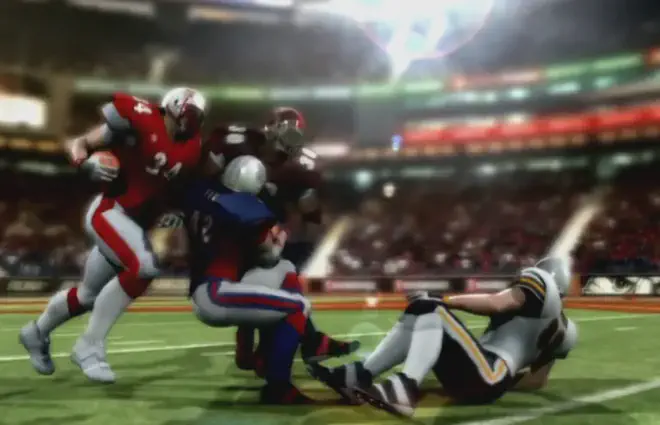Also available in video form here:
Introduction #
Dynamic Motion Synthesis, three words I grew to love over the past 5 years. Most people don’t understand what Dynamic Motion Synthesis is; these words sound familiar enough but out of context they don’t really convey much. Let me try to explain!
Dynamic Motion Synthesis is a system that generates animations through physics calculations. Miniscule implementations of Dynamic Motion Synthesis could be seen in loads of games which utilize a huge database of animations. Blending from an animation into a Ragdoll and back for instance is a bit trickier to get right than one might expect at first! It could also help to blend animations together which is especially important for sports games and third person shooter experiences. But what if we take the simulation even further?
Euphoria… What does it do? #
Natural Motions groundbreaking physics engines, Endorphin and the improved upon Euphoria Engine, showcase just how far we can take physicality in a video game. Thanks to Euphoria, Non Player Characters and even the Player character itself never Ragdoll. They possess a simulated nervous system and virtual muscles which tense up and relax just like our muscles do! What this also means is that artificial intelligence will allow certain things to happen without the player’s direct input. The Grand Theft Auto 4 trilogy, Red Dead Redemption and Backbreaker are perfect examples for this.
It does not take much for game characters to appear natural. For instance NPCs and the player character have an inherent sense of self preservation. When shot, bludgeoned, pushed or violently tackled, a character will naturally try to balance itself out. NPC’s will even protect their head and vital organs by assuming the fetal position. To be able to do this, every NPC needs to be a physics object. This system can have its downsides but depending on how the game addresses the issue it can be less dramatic or even be a desirable feature.
One common problem for the GTA 4 games especially, is sluggish movement. The Euphoria generated animations have a lot of weight behind them but it also takes more time for the player to turn around for instance, since the player character has to literally turn around.
Marrying Third Person Shooters with Euphoria #
Max Payne 3 made the movement lag into a feature rather than a bug. In this precise shooter movement is everything and being aware of your environment is a significant part of the battle. Thanks to combining thousands of animations and generated physics based animations, Max runs, turns, shoots and lunges seamlessly and in a physically responsive manner, but it does not take seconds to turn around anymore! Rockstar were able to take Max’s weight into account without crippling gameplay by mixing canned animations with simulated animations. Thanks to that we have precise somewhat cerebral gameplay in the shooting and movement departments, while retaining the fun of seeing Max get caught on a fence and slamming face down into the ground, or the frustration of lunging to the side only to have your shooting interrupted by Max violently slamming into a wall you were not aware of.
What Euphoria also takes into account is pain. In GTA games and Red Dead Redemption for instance, every shot affects an enemies aim. They might keep shooting, but the impact of a bullet can cause the NPC to stumble, crunch up or touch their wounds immediately after it happens. In Euphoria games you can regularly see pained grimaces on your foes after peppering them with bullets or bashing them with a baseball bat.
But even when the player severely wounds a NPC, in most cases they tend to stay alive. You can notice this by examining the limbs and general posture of the NPC’s body. When they are alive, there still is some tension in the body. The character first falls to the ground while trying to self preserve itself. At some point it will reposition itself to lay somewhat comfortably, mostly in the fetal position. When you shoot someone in the head, the body will go limp immediately. These details may go unnoticed by many which might be the reason why physics based game mechanics slowly vanished. But Euphoria also offers an untapped potential to make another genre of games ever more entertaining.
Introducing BACKBREAKER! #
Backbreaker is not only a great tech demo for Euphoria developed by Natural Motion themselves, it might also be the most realistic American football game that has ever seen the light of day. Combining a sport with lots of body contact, ample opportunities to tackle grab and score points with Dynamic Motion Synthesis seems to be a match made in heaven. The NPCs don’t only have a sense of self preservation in this application of the engine, they also understand the rules of American football. When tacklers come close, the ball carrier will reach his arm out to stop others coming close. As soon as a player receives a ball, they will catch it and appropriately hold and carry the ball.
When a player gets tackled near a line, the player will try to score a touchdown by grabbing the ball and extending his arm into the zone to score points. If he does not do that, he will at least appropriately defend the ball and crunch up to protect himself. Natural Motion knew how fun these physical interactions are for a player, so they implemented replay features for both Backbreaker and Backbreaker Vengeance to give players an opportunity to check out the violent tackles and entertaining failures.

Sadly the game has not managed to kickstart a revolution in the sports game genre. Electronic Arts holds a monopoly on it. Backbreaker was unpopular in the sports game community for featuring unconventional gameplay. A smaller community of players are still enthusiastic about this game. The main gripe sports fans have with Backbreaker is the over the shoulder perspective the game relies on, less the physical gameplay.
Another problem is that Electronic Arts possesses an exclusivity deal with the NFL, that means real world players and leagues can only be portrayed in an EA game, which stifles competition and makes it harder for other companies to break into the sports game genre.
Sadly Natural Motion’s Euphoria was not widely adopted in the industry. In the early 2000’s we saw a larger emphasis on physics based interactions in video games. It is the same time in which various Physics engines have been developed. For instance the incredibly famous Havok, the technically impressive but NVIDIA exclusive PhysX and also Natural Motion’s Endorphin, later Euphoria engine. If you are interested in checking out Euphoria, but do not have the money to purchase GTA 4 or Red Dead Redemption there is an alternative for you! Natural Motion created a game which is free to use and showcases the power of Euphoria on a phone screen.
Euphoria in Clumsy Ninja #
This phone game is called Clumsy Ninja and well… it is about a Clumsy Ninja! You can do various things to this guy! Attach balloons on his body to eventually make him float, throw him around in the scene, tickle him and even poke various parts of his body.
Even though this game features a cartoon art style, the physical interactions that we have with our Ninja are technically impressive! They are just as natural looking as Natural Motion’s Euphoria enabled sports game Backbreaker. Our Ninja will try to balance himself when unbalanced. Try to free himself when dragged around the scene. He will even express himself through gestures and blinking, all without using traditional animation!
The fact this system runs on a phone CPU is amazing to me and this proves that Euphoria might work just as well as a physics engine like Havok does on big budget console and PC experiences.
The latest game which came bundled with Euphoria physics, is Red Dead Redemption 2. Thanks to mods you can make the Euphoria system much more prevalent in gameplay. The system is not as dramatic as in GTA 4, Max Payne 3 or Red Dead Redemption, which is why this game only appears as a footnote. It is still there and works absolutely phenomenally though! But why EXACTLY is Euphoria not an industry standard at this point?
The real reason Euphoria is obscure… #
The Euphoria engine has a big flaw! It isn’t a software package that you buy, it rather is a consulting service for huge publishers. According to a Wolfire blog post, actually licensing the Euphoria engine is absolutely impossible. The Engine is implemented directly in your games codebase. Natural Motion helps your company in the implementation process for a steep cost. While other physics engines are open source, like PhysX and others have a reasonable price tag attached to them, like Havok, Euphoria is completely inaccessible. You can’t even find a trace of the software’s existence on Natural Motion’s own website! The only companies that have access to Euphoria and intend to use it are Rockstar, Disney and Natural Motion themselves.
That is the real reason why you don’t see incredibly realistic and satisfying ragdoll physics in video games. Euphoria has an incredibly exclusive business model which is profitable but limits who gets to use the technology.
At this point you are better off in writing your own Dynamic Motion Synthesis algorithm like the one Exanima possesses.
Changelog #
Edit 1 - 14/04/25 - Added video version embed via YouTube and video tag
